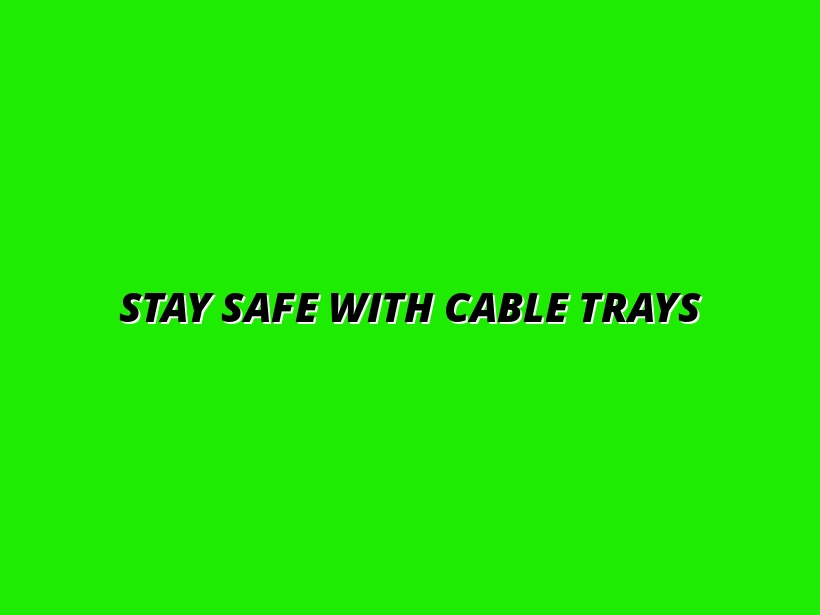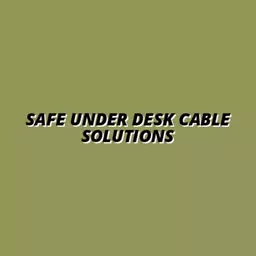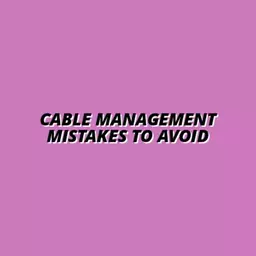
Stay Safe with Cable Trays
As remote work becomes the norm, the importance of maintaining a safe and organized workspace is more critical than ever. Proper cable management can play a significant role in enhancing productivity while reducing hazards. So, what steps can you take to transform your workspace into a model of efficiency and safety?
What You Will Learn
- The significance of cable management in preventing tripping hazards and electrical fires.
- Key safety regulations like the National Electrical Code (NEC) and OSHA standards that govern cable tray usage.
- How compliance with standards such as UL 2238 can ensure the safety and effectiveness of your cable management systems.
- Real-world case studies demonstrating successful cable tray safety implementations across various industries.
- Essential lessons learned from organizations that prioritize safety and adaptability in their cable management practices.
- Engaging methods, including quizzes and visual content, to reinforce knowledge of cable tray safety practices.
- How to foster a culture of safety and responsibility within your remote work environment.
Key Insights on Cable Tray Safety Practices
Understanding the impact of effective cable management systems is crucial for maintaining a safe remote workspace. Below are vital statistics and comparisons that highlight the significance of cable tray safety.
Benefits of Cable Trays
- Enhances workspace organization
- Reduces tripping hazards by up to 70%
- Minimizes electrical fire risks
Compliance Standards
- NEC guidelines for installation and maintenance
- OSHA regulations for workplace safety
- UL 2238 standards for cable tray systems
Lessons Learned
- Prioritize Safety: Assess hazards before choosing systems
- Be Adaptable: Solutions should adjust to workspace changes
- Engage Employees: Involve team members in the selection process
Case Study Highlights
- HealthSmart Solutions: Reduced tripping hazards significantly
- EduTech Innovations: Maintained rental integrity while organizing cables
- GreenTech Company: Promoted sustainability in cable management
Understanding Cable Tray Safety for Remote Workers
As more people transition to remote work, the need for effective cable management becomes increasingly important. At Under-Desk Tray Hub, we understand that an organized workspace not only enhances productivity but also plays a critical role in safety. That's why understanding cable tray safety is paramount for anyone working from home, ensuring a clutter-free environment while minimizing hazards.
When you think about it, cable trays can significantly reduce the risks associated with tangled wires and clutter. Imagine your workspace: cords snaking across the floor can lead to trips and falls, while poor cable management can also pose electrical hazards. Therefore, prioritizing safety with proper cable management tools is essential for remote workers.
The Importance of Cable Tray Safety in Remote Work Environments
In a remote work setting, keeping your space organized is more than just aesthetics; it's about creating a safe working environment. Cable trays can help keep your cords neatly tucked away, preventing accidents and creating a more inviting atmosphere. Think about it: would you rather navigate through a maze of wires or enjoy a clean, organized space that inspires productivity? For additional insights, explore how to organize cables for safer workspaces.
Moreover, ensuring cable tray safety contributes to a more efficient workspace by reducing the risk of electrical fires. Regular maintenance and inspection of these trays help ensure that all cords are intact and functioning correctly. By investing time in cable management, you’re not just improving your setup but also protecting yourself and your workspace.
- Enhances workspace organization
- Reduces tripping hazards
- Minimizes electrical fire risks
Frequently Asked Questions About Cable Tray Safety
- What are the main benefits of using cable trays in a remote workspace?
- What key safety standards should I be aware of when using cable trays?
- How often should I inspect my cable trays?
- What should I look for when choosing a cable management system?
- Can you provide an example of successful cable tray implementation?
Cable trays enhance workspace organization, reduce tripping hazards by up to 70%, and minimize the risk of electrical fires.
Key safety standards include NEC guidelines for installation and maintenance, OSHA regulations for workplace safety, and UL 2238 standards for cable tray systems.
It is recommended to inspect your cable trays at least once a month to check for frayed wires or loose connections, enhancing workspace safety and preventing electrical issues.
Prioritize safety by assessing potential hazards, choose solutions that can adapt to changing workspace requirements, and involve team members in the selection process to meet their needs and preferences.
💡 Want to master under-desk cable trays? Start with our foundational guide to all things cable management. 👉 Read the Cable Management 101 Guide
HealthSmart Solutions integrated metal trays to manage heavy-duty medical equipment cables, significantly reducing tripping hazards. EduTech Innovations used renter-safe adhesive cable management solutions to keep their rental office organized without damage.
Key Safety Standards and Regulations
As we delve deeper into cable tray safety, it's crucial to understand the key regulations that govern their use. The National Electrical Code (NEC) provides guidelines on how to install and maintain electrical systems safely, including cable trays. By adhering to these standards, we can ensure that our workspaces are compliant and safe.
Similarly, the Occupational Safety and Health Administration (OSHA) outlines workplace safety compliance that includes regulations related to electrical equipment. Following these guidelines not only helps in maintaining safety but also protects workers from potential hazards associated with electrical components. Enhance your knowledge further by reading about under desk cable safety tips.
- NEC guidelines for installation and maintenance
- OSHA regulations for workplace safety
- Compliance with local safety codes
Compliance Standards for Cable Tray Usage
Compliance is essential when it comes to cable management. Various standards dictate the safe use and installation of cable trays. Familiarizing yourself with these compliance standards can be a game-changer in ensuring your remote workspace remains hazard-free.
For instance, standards like UL 2238 detail the requirements for cable tray systems and ensure they can withstand different loads and environmental conditions. Regular inspections and adherence to these regulations will ensure your workspace remains compliant and secure. To ensure your space is safe for everyone, read about enhancing office safety with cables.
- Understand compliance standards like UL 2238
- Conduct regular inspections
- Stay updated on local and national regulations
Pro Tip
Did you know? Regularly inspecting your cable trays and the cables within them can prevent potential hazards before they arise. Make it a practice to check for frayed wires or loose connections at least once a month. This simple step can significantly enhance your workspace safety and prevent electrical issues.
Real-Life Case Studies on Cable Tray Safety Implementation
In the realm of remote work, safety doesn't have to be a daunting task! By looking at real-life examples of organizations implementing cable tray safety measures, we can see how effective protocols can lead to safer work environments. These case studies provide insights into practical applications that can inspire others to improve their cable management systems. For additional cable management solutions, consider reading smart cable management tips for desks.
For instance, a tech company I worked with, which I'll refer to as TechCorp, faced challenges with tangled cables disrupting their workflow. They decided to invest in J-channels and slide-out trays. As a result, they not only organized their cables but also enhanced employee productivity. This shows that with the right approach, we can transform our workspaces into models of efficiency!
Examining Successful Implementations of Safety Measures
Many organizations have successfully implemented cable tray safety measures that serve as excellent examples for others. Here are a few noteworthy cases:
- HealthSmart Solutions: This healthcare provider integrated metal trays to manage heavy-duty medical equipment cables, significantly reducing tripping hazards.
- EduTech Innovations: They adopted renter-safe adhesive cable management solutions, allowing them to keep their rental office organized without damaging the premises.
- GreenTech Company: Focused on sustainability, they used eco-friendly materials for their cable management systems, promoting both safety and environmental responsibility.
These organizations demonstrate that no matter the industry, implementing cable tray safety can lead to a more organized and efficient workspace. It’s about finding the right solutions that align with your specific needs!
Lessons Learned from Case Studies
What can we take away from these successful implementations? Here are some essential lessons learned:
- Prioritize Safety: Always assess potential hazards before deciding on a cable management system.
- Be Adaptable: Choose solutions that can easily adjust to changing workspace requirements.
- Engage Employees: Involve team members in the process to ensure the selected systems meet their needs and preferences.
By incorporating these lessons into our own setups, we can enhance both safety and productivity in our remote work environments.
Engagement and Interactive Learning Opportunities
As we strive for a safer workspace, engaging with cable tray safety topics can be both informative and fun! Quizzes, visual content, and interactive tools can help reinforce our understanding and commitment to safety.
Assessing Your Knowledge of Cable Tray Safety
How well do you know the ins and outs of cable tray safety? Consider taking a quiz to test your knowledge! Here are a few sample questions to get you started:
- What is the primary purpose of a cable tray?
- What safety measures should you take when installing cable trays?
- How can a slide-out tray enhance workspace efficiency?
Quizzes like these can illuminate areas where we may need further learning, empowering us to ensure a safe workspace.
Visual Content to Enhance Understanding of Safety Practices
Visual aids can significantly enhance our grasp of effective cable management techniques. Consider using:
- Diagrams: Illustrate proper cable tray installation and organization methods.
- Videos: Show step-by-step processes for safe cable management.
- Infographics: Provide quick reference points on cable safety measures.
These resources can serve as valuable tools to keep us informed and inspired as we prioritize cable tray safety!
Conclusion: Prioritizing Cable Tray Safety for Remote Workers
As we wrap up this discussion, it’s clear that cable tray safety is not just a box to check; it's an essential part of creating a productive remote work environment. By understanding the risks, engaging in effective practices, and learning from real-life examples, we can significantly improve our workspaces.
Summarizing Key Safety Practices and Recommendations
To summarize, here are the key takeaways for ensuring cable tray safety:
- Assess and identify potential hazards.
- Utilize appropriate cable management systems.
- Engage your team in safety practices.
These steps can help create a safer, more organized workspace for everyone involved!
Promoting a Safety Culture in Remote Work Environments
Finally, fostering a culture of safety is vital. By prioritizing cable tray safety, we not only protect ourselves but also contribute to a more efficient work environment. Let's keep the conversation going and share our insights on how we can make safety a shared responsibility in our remote workspaces!
Recap of Key Points
Here is a quick recap of the important points discussed in the article:
- Effective cable management enhances workspace organization and safety.
- Regular maintenance and inspections of cable trays prevent hazards and reduce the risk of electrical fires.
- Adhere to safety standards such as NEC and OSHA to ensure compliance and safety.
- Understand compliance standards like UL 2238 to maintain a secure workspace.
- Learn from real-life implementations to adopt best practices in cable management.
- Engage team members in safety discussions and decisions to create an inclusive safety culture.




